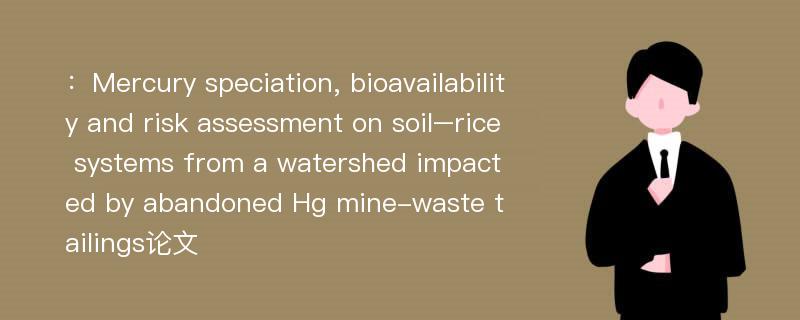
本文主要研究内容
作者(2019)在《Mercury speciation, bioavailability and risk assessment on soil–rice systems from a watershed impacted by abandoned Hg mine-waste tailings》一文中研究指出:Mercury(Hg) is a global pollutant and can be accumulated in the food chain, posing exposure risks to humans. In this study, rice plants and corresponding rhizosphere soil samples were collected from a watershed of the Wawu River Basin that is heavily impacted by historic Hg mining and retorting activities. Total mercury(THg)and methylmercury(MeHg) in rice grains, as well as other tissues and soil samples, were measured. Five soil Hg fractions, as well as soil parameters, were also determined.The results show that the average concentrations of THg and MeHg in rice grains were 14 ± 7.0 lg kg-1 and7.2 ± 4.0 lg kg-1. Soil organic-bound(Hg-o) and strong complex-bound(Hg-s) were the main Hg fractions,accounting for 44% of the total. To estimate the Hg–ligand interaction in the soils, soil-N/Hg(R = 0.451, p 0.05),-S/Hg(R = 0.372, p 0.1), and-OM/Hg ratio(R = 0.320,p 0.5) with MeHgsoil were observed with significant positive correlations, indicating that the formation of Hg–OM, Hg–N–OM or Hg–S–OM complexes could prevent Hg(II) from methylation in soils. The significant positive correlations of the-N/Hg ratio,-S/Hg ratio and-OM/Hg ratio with MeHg in rice tissues suggested that Hg methylation and MeHg demethylation occurred throughout the rice paddy ecosystem. The estimated MeHg daily intake(EDI) was 0.075 ± 0.041 lg kg-1 bw d-1 and was lower than the RfD level of 0.1 lg kg-1 bw d-1 recommended by the US EPA. However, approximately 29% of the hazardous index(HI) of MeHg in grain exceeded 1, posing a potential threat to local populations, particularly pregnant women and children.
Abstract
Mercury(Hg) is a global pollutant and can be accumulated in the food chain, posing exposure risks to humans. In this study, rice plants and corresponding rhizosphere soil samples were collected from a watershed of the Wawu River Basin that is heavily impacted by historic Hg mining and retorting activities. Total mercury(THg)and methylmercury(MeHg) in rice grains, as well as other tissues and soil samples, were measured. Five soil Hg fractions, as well as soil parameters, were also determined.The results show that the average concentrations of THg and MeHg in rice grains were 14 ± 7.0 lg kg-1 and7.2 ± 4.0 lg kg-1. Soil organic-bound(Hg-o) and strong complex-bound(Hg-s) were the main Hg fractions,accounting for 44% of the total. To estimate the Hg–ligand interaction in the soils, soil-N/Hg(R = 0.451, p 0.05),-S/Hg(R = 0.372, p 0.1), and-OM/Hg ratio(R = 0.320,p 0.5) with MeHgsoil were observed with significant positive correlations, indicating that the formation of Hg–OM, Hg–N–OM or Hg–S–OM complexes could prevent Hg(II) from methylation in soils. The significant positive correlations of the-N/Hg ratio,-S/Hg ratio and-OM/Hg ratio with MeHg in rice tissues suggested that Hg methylation and MeHg demethylation occurred throughout the rice paddy ecosystem. The estimated MeHg daily intake(EDI) was 0.075 ± 0.041 lg kg-1 bw d-1 and was lower than the RfD level of 0.1 lg kg-1 bw d-1 recommended by the US EPA. However, approximately 29% of the hazardous index(HI) of MeHg in grain exceeded 1, posing a potential threat to local populations, particularly pregnant women and children.
论文参考文献
[1].Effect of best management practice implementation on sediment and phosphorus load reductions at subwatershed and watershed scale using SWAT model[J]. Jasmeet Lamba,Anita M.Thompson,K.G.Karthikeyan,John C.Panuska,Laura W.Good. International Journal of Sediment Research.2016(04)[2].Key issues on watershed ecological security assessment[J]. GAO JiXI~1 ZHANG XiangHui~(2*) JIANG Yun~1 OU XiaoKun~3 HE DaMing~4 SHI JianBin~5 1 Chinese Research Academy of Environmental Sciences,Beijing 100012,China; 2 Civil and Environmental Engineering School,University of Science and Technology Beijing,Beijing 100083,China; 3 School of Resource Environment & Earth Science,Yunnan University,Kunming 650091,China; 4 Asian International River Center,Yunnan University,Kunming 650091,China; 5 EU-China Biodiversity Programme,Beijing 100044,China. Chinese Science Bulletin.2007(S2)[3].Soil and water loss in the Lancang River-Mekong River watershed (in Yunnan section, China) and its control measures[J]. WANG Hong 1, YAO Li xin 2* (1. Yunnan Environmental Monitoring Center Station, Kunming 650034, China; 2. Key Lab of Controlled|Release Preparations of Guangdong Province, Guangdong College of Pharmacy, Guangzhou 510240, China). Journal of Environmental Sciences.2000(01)[4].Water pollution control planning for the Taizi River watershed[J]. Jiang Weigong;Sun Hong(Benxi Environmental Monitoring Station, Liaoning Province ,Benxi 117021,China)Guo Huaicheng;Song Guojun (Center for Environmental Sciences,Peking University.Beijing 100871.China). JOURNAL OF ENVIRONMENTAL SCIENCES.1996(01)[5].Spatial distribution, sources and ecological risk assessment of heavy metals in Shenjia River watershed of the Three Gorges Reservoir Area[J]. WANG Yong-yan,WEN An-bang,GUO Jin,SHI Zhong-lin,YAN Dong-chun. Journal of Mountain Science.2017(02)[6].Nitrogen sink in a small forested watershed of subtropical China[J]. Laiming Huang 1,2,Jinling Yang 1,2,Ganlin Zhang 1,2,1.State Key Laboratory of Soil and Sustainable Agriculture,Institute of Soil Science,Chinese Academy of Sciences,Nanjing 210008,China.2.Graduate School of Chinese Academy of Sciences,Beijing 100049,China. Journal of Environmental Sciences.2011(03)[7].Watershed environmental management framework based on economic theory[J]. Baoliu Zhang,Hong Luo,Zhengqing Wang. Chinese Journal of Population,Resources and Environment.2014(04)[8].Non-point source pollution of Wujiang River watershed in Guizhou Province, SW China[J]. Congguo TANG1,2, Congqiang LIU1 1 State Key Laboratory of Environmental Geochemistry, Institute of Geochemistry, Chinese Academy of Sciences, Guiyang 550002, China 2 Graduate School, Chinese Academy of Sciences, Beijing 100049, China. Chinese Journal of Geochemistry.2006(S1)[9].Benefit Evaluation on the Control Mode for Typical Karst Rocky Desertification in Guizhou Province,China[J]. ZUO Xing-jun~1*,ZUO Tai-an~2,XU Shu-jian~31.Linyi Vocational College,Linyi 276000,China;2.Department of Environmental and Life Sciences,Bijie University,Bijie 551700,China;3.College of Chemistry and Resources Environment,Linyi Normal University,Linyi 276000,China. Asian Agricultural Research.2010(07)[10].Emergy evaluation of the artificial forest ecosystems in the watershed of Miyun Reservoir:a case study for ecosystems valuation and environmental management[J]. Hu Yanxia 1, Zhou Liandi 1 *, Dong Xiaobin 2, Yan Maochao 3, 4 1. Institute for Integrated Development of Agriculture, Beijing Academy of Ago-forestry Sciences, Beijing 100097, P. R. China 2. Institute of Resource, Beijing Normal University, Beijing, 100875, P. R. China 3. College of Agronomy and Biological Technology, China Agricultural University, Beijing 100094, P. R. China 4. Institute of Geographical Sciences and Natural Resource Research, CAS, Beijing 100101, P. R. China. Ecological Economy.2007(04)
论文详细介绍
论文作者分别是来自Acta Geochimica的,发表于刊物Acta Geochimica2019年03期论文,是一篇关于,Acta Geochimica2019年03期论文的文章。本文可供学术参考使用,各位学者可以免费参考阅读下载,文章观点不代表本站观点,资料来自Acta Geochimica2019年03期论文网站,若本站收录的文献无意侵犯了您的著作版权,请联系我们删除。
标签:Acta Geochimica2019年03期论文;
:Mercury speciation, bioavailability and risk assessment on soil–rice systems from a watershed impacted by abandoned Hg mine-waste tailings论文
下载Doc文档
